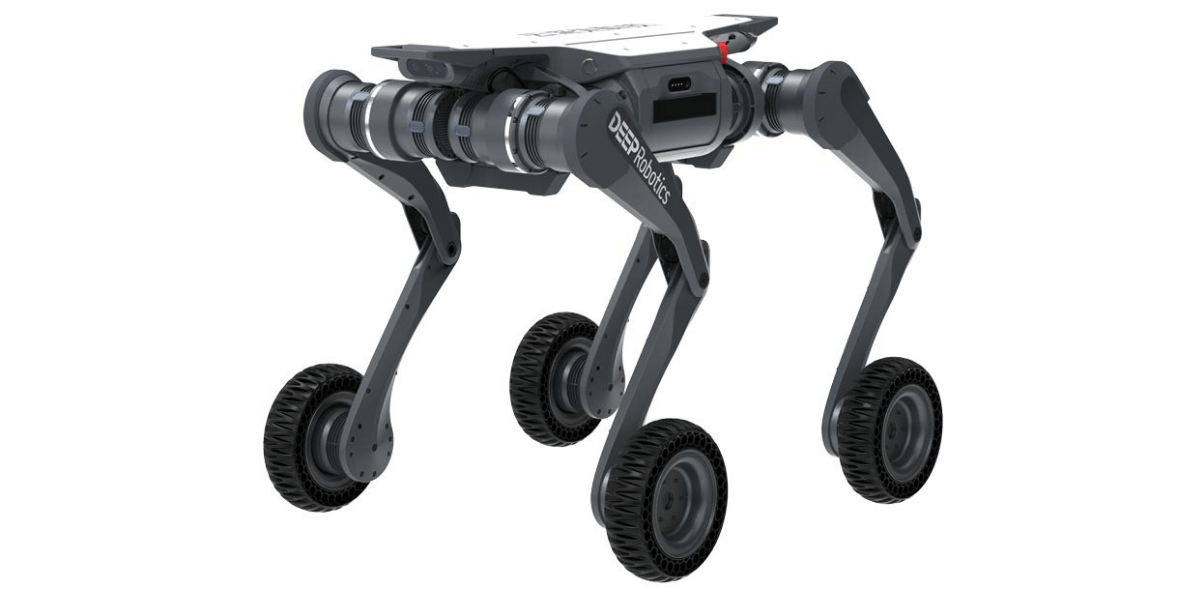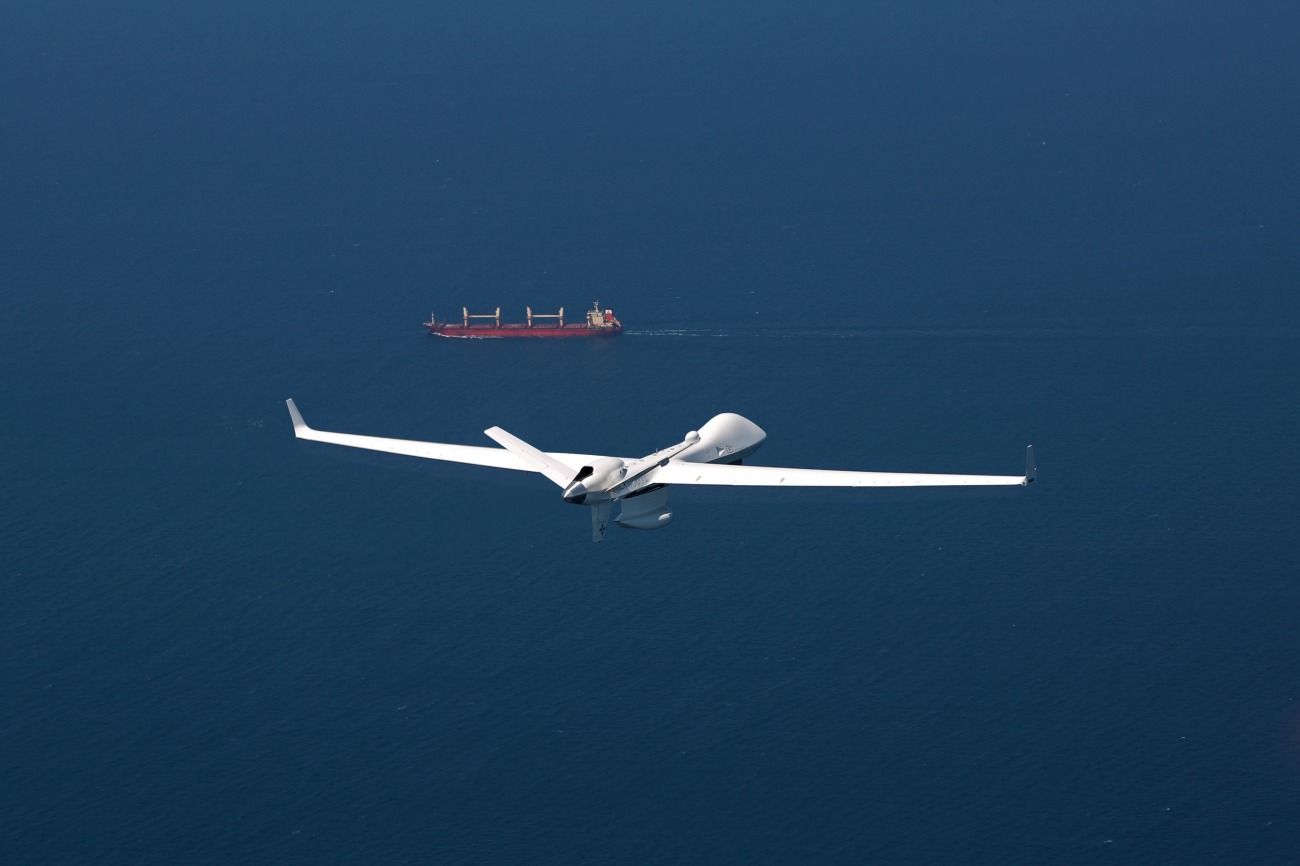OPED By Air Marshal Anil Khosla (R)
China has unveiled the “Lynx” advanced quadruped robot designed for rugged, off-road environments. It can navigate extreme terrain at high speeds and perform stunts like backflips and sharp turns, enhancing its utility in real-world applications like disaster response, combat situations, and exploration.
Designed by the Chinese company Deep Robotics, the robot is significant in China’s broader strategy of embracing unmanned warfare.
Lynx Robot
Deep Robotics, founded in 2017, has made a name for itself with its innovative quadruped robots. The Lynx represents a leap forward in terms of versatility and performance. Its all-terrain wheels allow it to cover uneven ground easily.
Thanks to its waterproof design, it can operate in challenging conditions, including temperatures ranging from -20°C to 55°C and even in wet environments.
The Lynx can autonomously navigate challenging environments for up to 4 hours on a single charge. This robot has garnered attention for its practical applications in search and rescue, mapping, inspection, and potential military uses.
Possible Military Application
The Lynx robot by Deep Robotics, with its rugged capabilities, mobility, and autonomous navigation of extreme terrains, presents several potential military applications.
These features make it suitable for various tactical and logistical operations in military contexts, from reconnaissance missions in complex environments to providing logistical support in combat zones.

Reconnaissance and Surveillance: The Lynx’s ability to traverse complex environments— such as rough, mountainous terrain or urban rubble—makes it ideal for reconnaissance missions. Its autonomous navigation capabilities allow it to gather intelligence in areas that are too dangerous or difficult for human soldiers to access, providing real-time data without risking lives.
Logistical Support: The robot’s capacity to carry heavy loads and its off-road agility make it a potential asset in logistical operations, particularly in combat zones. It could transport supplies, ammunition, and equipment across uneven terrain, ensuring that military units are well-supplied in challenging environments.
Search and Rescue Operations: Given its versatility and ability to function in extreme conditions, the Lynx could be used in military search and rescue operations. It can be deployed in environments where traditional vehicles may struggle, such as collapsed buildings or hazardous zones after combat.
Explosive Ordnance Disposal (EOD): The robot’s agility, ability to handle rough terrain, and precision could make it a valuable tool in EOD operations. It would allow military personnel to remotely detect and disarm explosives in hostile areas without exposing humans to danger.
The Lynx’s robust design and all-terrain features lend it to military applications. As with many advanced robotic systems, its military potential could be seen as a means to reduce human casualties and enhance combat capabilities.
Future Warfare With Unmanned Systems
Unmanned systems, including unmanned aerial vehicles (UAVs) and unmanned ground vehicles (UGVs), are rapidly transforming modern warfare.
With technological advancements, these systems have moved from the periphery of military operations to the forefront, providing unprecedented surveillance, reconnaissance, logistics, and combat capabilities.
This article explores the tactical applications of unmanned systems in future warfare, illustrated with examples, insights from military experts, and a look at the implications for global security.
The Evolution Of Unmanned Systems
The concept of unmanned systems is not new; however, their application has dramatically evolved over the past two decades. Initially utilized primarily for reconnaissance missions during the Cold War, UAVs gained prominence in the 1990s and early 2000s, particularly in the U.S. military’s operations in the Middle East.
The 2001 invasion of Afghanistan and the subsequent Iraq War marked a turning point where UAVs like the MQ-1 Predator and MQ-9 Reaper became integral to combat operations, enabling real-time intelligence gathering and targeted strikes without risking pilot lives.

A 2021 U.S. Defence Innovation Board report states, “Unmanned systems are reshaping how wars are fought, enabling forces to conduct operations with greater precision, efficiency, and reduced risk to personnel.”
Tactical Applications Of Unmanned Aerial Vehicles (UAVs)
Surveillance and Reconnaissance: One of the primary applications of UAVs is for surveillance and reconnaissance missions. The ability to gather intelligence over vast areas without risking human life is invaluable. For example, during the 2012 conflict in Mali, French forces employed UAVs to monitor enemy movements and gather intelligence on insurgent groups. This enabled precise ground operations planning, significantly improving their forces’ effectiveness.
Precision Strikes: UAVs have also become crucial in delivering precision strikes against high-value targets. The use of drones for targeted killings has been a controversial yet effective tactic. Israel’s use of UAVs in conflicts, such as the 2006 Lebanon War, demonstrated the effectiveness of drones in both surveillance and combat roles. The Israeli Air Force’s use of the Heron and Hermes UAVs allowed for persistent monitoring and targeted strikes, significantly impacting Hezbollah’s capabilities.
Logistics and Resupply: Unmanned systems are also revolutionizing military logistics. The U.S. Army has begun to deploy UAVs for logistical support, delivering supplies to frontline troops. This capability was notably highlighted during the 2020 Nagorno-Karabakh conflict, where Azerbaijani forces utilized UAVs not only for combat but also for logistical operations, effectively resupplying troops in the field while minimizing the risk of ground convoys being attacked.
Tactical Applications Of Unmanned Ground Vehicles (UGVs)
Combat Support and Logistics: Unmanned ground vehicles (UGVs) are increasingly integrated into combat operations. These systems can perform various tasks, including surveillance, logistics, and direct enemy forces engagement.
The U.S. Army’s Robotic Combat Vehicle (RCV) program exemplifies this trend, as it aims to develop UGVs that can operate alongside manned units to enhance combat effectiveness. The UGVs deployed in recent military exercises have demonstrated their ability to scout ahead of troop formations, providing critical intelligence without endangering soldiers.
Counter-Improvised Explosive Device (C-IED) Operations: UGVs are particularly effective in counter-IED operations, where they can safely detect and disarm explosive devices. The U.S. military has employed systems like the PackBot and Talon, successfully reducing casualties among dismounted troops. During operations in Afghanistan, UGVs were instrumental in clearing routes for ground convoys by detecting and neutralizing IED threats.
Humanitarian Assistance and Disaster Relief (HADR): UGVs are also involved in humanitarian assistance and disaster relief operations. In the aftermath of natural disasters, these vehicles can be deployed to assess damage, locate survivors, and deliver supplies. For instance, after the 2011 earthquake and tsunami in Japan, UGVs were used to navigate debris and assess the condition of affected areas, demonstrating their versatility beyond traditional military applications.
Future Warfare And The Role Of Unmanned Systems
As warfare continues to evolve, the role of unmanned systems will only expand. Integrating artificial intelligence (AI) and machine learning into unmanned systems will enhance their capabilities, enabling them to operate autonomously in complex environments. This shift toward autonomy presents both opportunities and challenges for military planners.
Enhanced Decision-Making: Integrating AI into unmanned systems will improve decision-making in combat scenarios. AI algorithms can analyze vast amounts of data from multiple sources, providing commanders with actionable intelligence and recommendations for operations. The future battlefield will be defined by speed and the ability to process information faster than the enemy.

Ethical Considerations: However, the increasing reliance on unmanned systems raises significant ethical questions. The use of drones for targeted killings has sparked debate over accountability and the rules of engagement. As military operations become more automated, the question of human oversight becomes critical. Experts argue that while unmanned systems can enhance operational efficiency, they must be governed by strict ethical guidelines to prevent misuse and collateral damage.
Global Security Implications: The proliferation of unmanned systems is reshaping global security dynamics. As countries like China and Russia invest heavily in their drone capabilities, the balance of power is shifting. The use of UAVs in conflicts such as the Syrian Civil War and the ongoing tensions in the South China Sea highlights the strategic importance of these systems in contemporary military strategies.
China’s Investment In Unmanned Systems
China has heavily invested in unmanned systems as part of its broader goal to modernize its military and lead in technological innovation. These investments are spread across several key sectors, including unmanned aerial vehicles (UAVs), unmanned underwater vehicles (UUVs), and unmanned surface vessels (USVs). These technologies have military, commercial, and strategic implications that extend beyond China’s borders.
Unmanned Aerial Vehicles (UAVs): China is a global leader in UAV technology, mainly through the success of companies like DJI, which dominate the global drone market, controlling up to 70% of the worldwide share. China’s military has also developed advanced UAVs, including surveillance, reconnaissance, and strike capabilities. The Wing Loong series, for example, is a family of Chinese UAVs designed for intelligence gathering and targeted strikes. These UAVs are being developed for domestic consumption and export purposes, making China a significant player in the global defense drone market.
Unmanned Surface Vessels (USVs): China is making significant strides in developing USVs, which are used for surveillance, reconnaissance, and mine detection. These unmanned vessels are seen as cost-effective alternatives to manned naval operations, offering the ability to patrol contested waters like the South China Sea without risking human life. USVs also help maintain a constant presence in strategic maritime regions. These vessels align with China’s broader naval ambitions to assert its presence and power projection capabilities in the Indo-Pacific.
Unmanned Underwater Vehicles (UUVs): China’s investment in UUVs has been critical to its maritime strategy, particularly in the South China Sea and other key waterway areas. These vehicles are essential for underwater surveillance, anti-submarine warfare, and potentially offensive operations against rival naval forces. China’s UUV technology has evolved to encompass various capabilities, from scientific exploration to military applications, such as the Haisi underwater vehicle series.
Strategic and Military Applications: China’s investments are strategically aimed at bolstering its military capabilities, enhancing its surveillance capabilities, and reducing operational risks. By focusing on unmanned systems, China can maintain a technological edge in surveillance, reconnaissance, and potential combat operations. The country’s Military-Civil Fusion policy further accelerates the integration of civilian technological advances into the military, making these unmanned systems even more pivotal for national defense and global influence.
Global Influence And Export Strategies
China’s dominance in the unmanned systems market has implications for its foreign policy and international influence. While Western countries like the U.S. have stricter export controls on unmanned systems, China’s more flexible approach allows it to export these technologies widely, especially to developing countries.
This has led to China’s increasing presence in markets previously dominated by Western companies, positioning it as a critical player in the global defense and technology sectors.
China’s strategic investments in unmanned systems are part of a broader national ambition to lead in defense technology while reducing reliance on traditional military platforms.
The country’s dominance in the drone market and advancements in USVs and UUVs make unmanned systems a cornerstone of China’s military modernization efforts and broader geopolitical ambitions.
These investments strengthen China’s defense capabilities and enhance its influence across global markets, particularly in rising geopolitical tensions in the Indo-Pacific and other strategic regions.
The increasing use of unmanned systems by state and non-state actors presents a new paradigm in warfare, challenging traditional military doctrines and necessitating a re-evaluation of defense strategies.
As nations continue to develop and deploy unmanned systems, it is imperative to balance leveraging their capabilities and ensuring accountability in their use. These technologies will undoubtedly shape the future of warfare, making it essential for military leaders and policymakers to understand their implications for global security.
- Air Marshal Anil Khosla PVSM, AVSM, VM, is a former Vice Chief of Air Staff (VCAS) of the Indian Air Force and AOC in C of Eastern Air Command.
- VIEWS PERSONAL OF THE AUTHOR
- He tweets at: @AnilKhosla16
- Email EurAsian Times at editor (at) eurasiantimes.com




